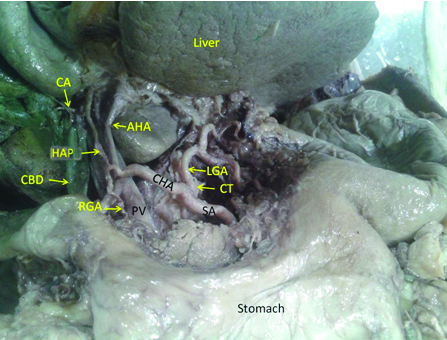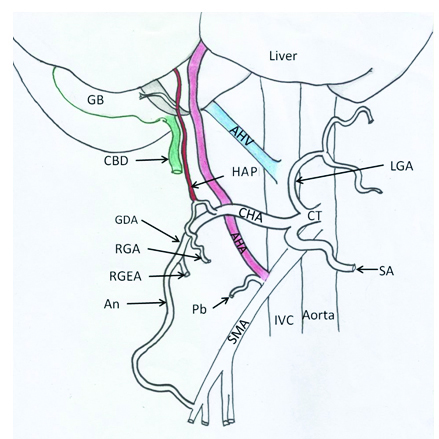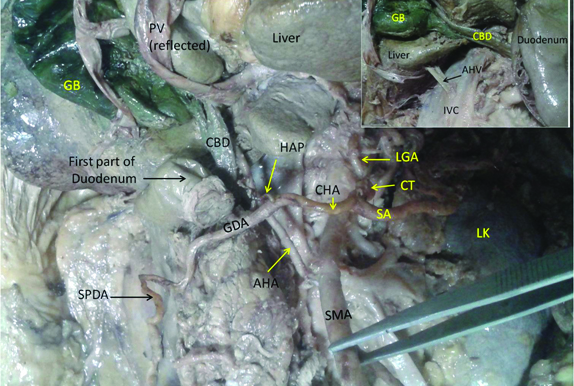Variant Anatomy of the Hepatic Vasculature: Importance in Hepatobiliary Resections
Sarika Rachel Tigga1, Sandeep Saluja2, Virendra Budhiraja3, Rakhi Rastogi4
1 Assistant Professor, Department of Anatomy, ESIC Medical College and Hospital, Faridabad, Haryana, India.
2 Assistant Professor, Department of Anatomy, G S Medical College and Hospital, Pilkhuwa, Hapur, Uttar Pradesh, India.
3 Professor and HOD, Department of Anatomy, Kalpana Chawla Government Medical College, Karnal, Haryana, India.
4 Professor, Department of Anatomy, G S Medical College and Hospital, Pilkhuwa, Hapur, Uttar Pradesh, India.
NAME, ADDRESS, E-MAIL ID OF THE CORRESPONDING AUTHOR: Dr. Sandeep Saluja, Flat No. KM00030806, KM-03, Kosmos, Jaypee Greens Wish Town, Sector-134, Noida-201304, Uttar Pradesh, India.
E-mail: sandeep.saluja1980@gmail.com
A variant anatomy of the hepatic vasculature has a clinically significant role in hepatobiliary transplantation, redivtion, tumour embolisation as well as in extrahepatic abdominal surgeries involving the stomach, pancreas or gall bladder. During routine cadaveric disdivtion, we observed a case of unusually small calibre hepatic artery proper. An accessory hepatic artery was seen emerging from the superior mesenteric artery to the right hepatic lobe along with an accessory hepatic vein from the right hepatic lobe that drained directly into the inferior vena cava. Such accessory hepatic vessels complicate and necessitate an alteration of surgical methodology during redivtion of hepatic lobes. Preoperative knowledge of variant hepatic vasculature is crucial for minimising the iatrogenic injury and facilitating successful abdominal surgeries.
Case Report
Routine cadaveric dissection of the abdomen in a 58-year-old male exposed a variant hepatic vasculature. The Coeliac Trunk (CT) and superior mesenteric artery (SMA) originated collectively at the level of T12/L1 vertebral bodies.
The diameter of the CT at its base was 0.7 cm and its total length was 3.2 cm. At a distance of 1.5 cm ventral from the point of origin of the CT, the Left Gastric Artery (LGA) was first given off. After coursing 1.7 cm downwards and to the left, the CT bifurcated into its remaining two branches: Splenic Artery (SA) (diameter=0.62 cm) and Common Hepatic Artery (CHA) (diameter=0.5 cm). The LGA and SA were found to be normal in their course and branching pattern [Table/Fig-1].
Dissection of the hepato-biliary region of the abdomen showing an unusually small Hepatic Artery Proper (HAP) arising from the Common Hepatic Artery (CHA) [CA: Cystic Artery; CT: Coeliac Trunk, CHA; Common Hepatic Artery; LGA: Left Gastric Artery; SA: Splenic Artery; RGA: Right Gastric Artery; PV: Portal Vein; CBD: Common Bile Duct].

The CHA on reaching the superior aspect of the first part of duodenum, gave off the Gastroduodenal Artery (GDA) (diameter= 0.45 cm) and an unusually small Hepatic Artery Proper (HAP) (diameter= 0.20 cm) that diminished in size as it travelled upwards to the liver. The Cystic Artery (CA) was seen arising directly from the HAP. The Right Gastroepiploic Artery (RGEA) was given off from the GDA to the greater curvature of the stomach, while the GDA continued downwards as the Superior Pancreaticoduodenal Artery (SPDA) to directly anastomose with the Inferior Pancreaticoduodenal Artery (IPDA) along the C-shaped concavity of the duodenal loop. A small calibre (diameter=0.18 cm) Right Gastric Artery (RGA) arose from the HAP to supply the lesser curvature of stomach [Table/Fig-2].
Diagrammatic representation showing accessory Hepatic Artery (AHA) and Accessory Hepatic Vein (AHV). [Also showing – HAP: Hepatic Artery Proper, CT: Coeliac Trunk, CHA: Common Hepatic Artery, LGA: Left Gastric Artery, SA: Splenic Artery, SMA: Superior Mesenteric Artery, GDA: Gastroduodenal Artery, RGA: Right gastric Artery, RGEA: Right Gastroepiploic Artery, An: Anastomosis between Superior and Inferior Pancreaticoduodenal Artery, Pb: Pancreatic branch, IVC: Inferior Vena Cava, GB: Gall Bladder, CBD: Common Bile Duct]

In addition to HAP, an Accessory Hepatic Artery (AHA) was seen emerging from the Superior Mesenteric Artery (SMA) which was comparatively larger in calibre (diameter:0.38 cm; length=8.2 cm) than the HAP. After arising 4.5 cm distal to the origin of the SMA, the AHA coursed upwards and to the right passing behind the pancreas. Further, it ran upwards behind the HAP and Portal Vein (PV) and on the left side of Common Bile Duct (CBD) to ultimately reach the right lobe of the liver. A pancreatic branch was also seen arising from the base of the AHA. Besides the AHA, we noticed an Accessory Hepatic Vein (AHV) emerging from the right lobe (Couinaud’s Segment VII) of the liver. It travelled downwards and to the left to finally drain into the IVC directly [Table/Fig-2,3].
Dissection showing Coeliac Trunk (CT) and its branches and an Accessory Hepatic Artery (AHA) arising from the Superior Mesenteric Artery (SMA). (Stomach has been removed and Portal Vein (PV) reflected above.) Inset: Dissection shows an Accessory Hepatic Vein (AHV) draining the posterior aspect of the right lobe of liver into the Inferior Vena Cava (IVC). [CT: Coeliac Trunk, CHA: Common Hepatic Artery, LGA: Left Gastric Artery, SA: Splenic Artery, CBD: Common Bile Duct, SMA: Superior Mesenteric Artery, GDA: Gastroduodenal Artery, LK: Left Kidney, GB: Gall Bladder, SPDA: Superior Pancreaticoduodenal Artery, PV: Portal Vein].

Discussion
The CT is a ventral branch of Abdominal Aorta (AA) arising at the level of T12/L1 vertebral bodies. The CT is 1.5-2 cm long and usually supplies the foregut through its three main branches: the LGA, SA and CHA. After its origin, the CHA courses forwards and laterally beneath the epiploic foramen to reach the superior surface of the first part of the duodenum. The CHA further divides into the HAP and the GDA. The HAP ascends in front of the epiploic foramen between the layers of the lesser omentum where it is related to the CBD laterally and the PV posteriorly. At the porta hepatis, HAP divides into Right (RHA) and Left (LHA) Hepatic Arteries just before entering the liver parenchyma [1]. However, in the present case, the course of the HAP and its branches, could not be traced to its termination owing to its diminutive size and fragility and was regrettably lost in the thick fascia of the porta hepatis. Hence, we were unable to comment on the RHA and LHA. However, the CA was seen arising from the HAP.
The variations of the Hepatic Arteries (HA) are usually of two categories: the accessory and the replaced hepatic arteries. The AHA is a vessel that supplies a hepatic lobe besides its usual blood supply; whereas, the RHA signifies a vessel that does not initiate from a conventional site and is the single supply to a particular hepatic lobe [1]. Usually, the right AHA/RHA originates from the SMA and the left AHA/RHA emerges from the LGA. Infrequently, these variant vessels can arise from the GDA, CT, or the AA [2].
HA can exhibit multiple configurations of the origin and branching pattern which can affect the outcome of operative procedures on liver. In spite of the improvement in techniques of hepatic surgery pertaining to microvascular reconstruction, vascular complications still constitute a significant fraction in morbidity and mortality. Hence, comprehensive knowledge of the variable anatomy of the HA is essential for planning of surgical and interventional procedures such as liver transplantation and hepatic arterial infusion chemotherapy [3,4].
Classical anatomy of the hepatic vessels provided by Couinaud’s division of the liver into eight segments provides a blueprint of the vascular supply of liver. However, several vascular variants have been illustrated. Araujo Neto SA et al., reported variations of hepatic arterial system in 21.7% cases. The most common anatomical variation observed, was the anomalous origin of RHA in 8.5% cases. The RHA originated either from the SMA (5.1% cases) or the CT (3.4% cases). LHA variations were noted in 5.1% cases and either emerged from the CHA (3.4% cases) or from the LGA (1.7%).
The trifurcation of the HAP was observed in 3.4% cases which presented with a middle hepatic artery [5]. Jelev L et al., found an extraordinarily small HAP supplying the left lobe of liver, in addition to an accessory LHA originating from the LGA. A large replaced RHA was also noted emerging from the SMA [6]. Ugurel MS et al., noticed hepatic artery variations in 48% patients. The most common variations were replaced RHA (in 17% patients), replaced LHA (in 11% patients) and accessory LHA (in 10% patients) [7]. Song SY et al., observed CHA variations in 3.71% patients and CHA originating from SMA was the most common variation (in 3% patients) [8].
Such variations of the hepatic arterial system can be explained by its embryonic development. In early gestational life, the liver is supplied by three main arteries: the LHA from the left gastric artery, the RHA from the SMA and the middle hepatic artery from the CT. With further development, the embryonic left and right hepatic arteries regress while the middle hepatic artery persists as the CHA and further divides to establish the adult hepatic vasculature. The partial or complete failure in regression of the embryonic arteries can give rise to variable branching pattern of hepatic arteries [2,9,10]. We observed an AHA originating from the SMA which may be due to persistence of the embryonic RHA. Further, very small calibre HAP and RGA noted in the present case tend to increase the chances of excessive bleeding as these vessels apart from being fragile, are difficult to locate during surgery.
The morphogenesis of vitelline veins provides a perspective on the occurrence of accessory hepatic veins. At around the fourth week of development, the vitelline veins form a meshwork of sinusoids between the cords of the endodermal cells in the septal mesenchyme. These sinusoids are perfused by blood derived from umbilical and vitelline veins via vessels called venae advehentes and drained by a set of four venae revehentes opening into the corresponding horns of the sinus venosus. This stage of four hepatocardiac veins is transient and is ultimately replaced by one dominant channel - the right hepatocardiac channel that ultimately forms the terminal segment of the IVC. The right venae revehentes and new channels draining territories of the left venae revehentes communicate with the terminal segment of the IVC and variable venous patterns may develop depending upon absorption or persistence of these channels [11].
The foundation of a successful hepatectomy rests on the acquisition of a graft that exhibits a balance between arterial supply and venous drainage. Failure to recognise a significant AHV preoperatively may cause excessive bleeding; compromise the venous drainage of the graft or venous congestion may ruin the implanted graft, often causing its failure. In the present case, an AHV drained the right hepatic lobe (Couinaud’s Segment VII) directly into the IVC. Such an AHV should be left intact or reconstructed to the greatest extent [12].
Hepatobiliary surgeries and radiological interventions such as chemoembolisation of hepatic tumours rely heavily on the surgeon’s awareness of the normal and variant hepatic vasculature [13]. Along with the introduction of minimally invasive laparoscopic and robotic surgeries, meticulous knowledge of such variations can avoid iatrogenic injury and minimise complications during various surgical and interventional procedures.
Conclusion
The present case highlights the recurrent existence of accessory hepatic vessels. Though they increase the surgical complexity and necessitate alteration of surgical techniques, they must be considered as an additional resource of perfusion or drainage that may increase the chances of graft acceptance.
[1]. Standring S, Gray’s Anatomy:The Anatomical Basis of Clinical Practice 2008 40th edScotlandChurchill Livingstone Elsevier [Google Scholar]
[2]. Chanasong R, Putiwat P, Roboon J, Sakulsak N, Accessory Hepatic Artery Arising from Celiac Trunk:An Incidence in a Thai Cadaver Int J Morphol 2014 32(4):1136-39. [Google Scholar]
[3]. Gumus H, Bukte Y, Ozdemir E, Senturk S, Tekbas G, Onder H, Variations of the celiac trunk and hepatic arteries:a study with 64-detector computed tomographic angiography Eur Rev Med Pharmacol Sci 2013 17(12):1636-41. [Google Scholar]
[4]. Zagyapan R, Kurkcuoglu A, Bayraktar A, Pelin C, Aytekin C, Anatomic variations of the celiac trunk and hepatic arterial system with digital subtraction angiography Turk J Gastroenterol 2014 25(1):104-09. [Google Scholar]
[5]. Araujo Neto SA, Franca HA, Mello Junior CF, Silva Neto EJ, Negromonte GR, Duarte CM, Anatomical variations of the celiac trunk and hepatic arterial system:An analysis using multidetector computed tomography angiography Radiol Bras 2015 48(6):358-62. [Google Scholar]
[6]. Jelev L, Angelov AK, A rare type of hepatobiliary arterial system in man-presence of accessory left and replaced right hepatic arteries and double cystic arteries Anatomy 2015 9:100-03. [Google Scholar]
[7]. Ugurel MS, Battal B, Bozlar U, Nural MS, Tasar M, Ors F, Anatomical variations of hepatic arterial system, coeliac trunk and renal arteries:An analysis with multidetector CT angiography Br J Radiol 2010 83(992):661-67. [Google Scholar]
[8]. Song SY, Chung JW, Yin YH, Jae HJ, Kim HC, Jeon UB, Celiac axis and common hepatic artery variations in 5002 patients:Systematic analysis with spiral CT and DSA Radiology 2010 255(1):278-88. [Google Scholar]
[9]. Bhardwaj N, Anomalous origins of hepatic artery and its significance for hepatobiliary surgery J Anat Soc India 2010 59(2):173-76. [Google Scholar]
[10]. Dandekar UK, Dandekar KN, Variant anatomy of the celiac trunk–review of literature with a case report International Journal of Biomedical and Advance Research 2014 5(10):480-84. [Google Scholar]
[11]. Williams PL, Bannister LH, Berry MM, Collins P, Dyson M, Dussek JE, Gray’s Anatomy 1998 38th edNew YorkChurchill Livingstone [Google Scholar]
[12]. Kalayci TO, Kutlu R, Karasu S, Yilmaz S, Investigation of right lobe hepatic vein variations of donor using 64-detector computed tomography before living donor liver transplantation Turk J Gastroenterol 2014 25(1):09-14. [Google Scholar]
[13]. D’Souza AS, Vijayalakshmi H, Pugazhandhi HM, Anatomical variations in the branches of the coeliac trunk J Clin Diagn Res 2012 6(3):333-35. [Google Scholar]